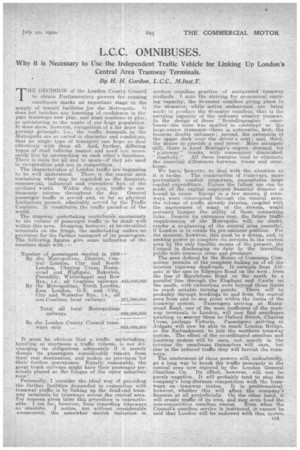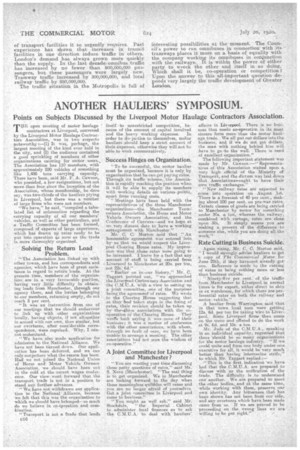L.C.C. OMNIBUSES.
Page 13

Page 14

If you've noticed an error in this article please click here to report it so we can fix it.
Why it is Necessary to Use the Independent Traffic Vehicle for Linking Up London's Central Area Tramway Terminals.
By H. H. Gordon, L.C.C., PLInst.T.
THE DECISION of the Landau County Council to obtain Parliamentary powers for running omnibuses marks an important stage in the. wpply of transit facilities for the Metropolis. It does not. betoken any lessening of confidence in the part tramways now play, and must continue to play, an ministering to the wants of our huge population. It does show, however, recognition of a far more important principle, i.e., the traffic demands in the Metropolis are so varied in character and conditions, that no single -type of transport can hope to deal effectively with them all. And, further, differing types of road vehicles cannot. and need not necessarily live by encroaching on each other's functions. There is room for all and to spare—if they are used in co-operation and-not in competition. The characteristics of London traffic are beginning to be well understood. There is the central area containing what may he regarded as the financial, commercial, industrial and recreative hub of the civilized world. Within this area, traffic is continuously intense throughout the day. General passenger traffic is served and, so far as physical limitations permit, admirably served by the Traffic Combine. It constitutes the traffic paradise Of the
world. .
The tramway -undertaking contributes enormously to the volume of passenger traffic to he dealt with within this area. Stopping, however, at inconvenient terminals on the fringe, the undertaking makes no provision for the further transport of its passengers.. The following figures give some indication of the numbers dealt with
, It must be obvious that a traffic undertaking, ,bandling so enormous a traffic volume, is not duicharging its obligations. adequately if it merely
• dumps its passengers considerably remote from their real destination, and makes no provision for their further eonvey-ance. Equally reasonably, the great 'trunk railways might have their passenger •terminals placed at the fringes of the outer suburban
zone! • • Personally, I consider the ideal way of providing the further facilities demanded in connection with tramway traffic is by linking up the dead-end tramway terminals by tramways across the central area. For reasons given later this procedure is impracticable.. I am far, however, from regarding tramways
as -obsolete. I notice, riot without considerable amusement, the somewhat slavish imitation in modern omnibus practice of antiquated tramway methods. I note the striving for economical carrying capacity, the 34-seater omnibus giving place to the 46-seater, while active endeaveurs are being made to produce the 60-seater. omnibus, that is the carrying capacity of the Ordinary country tramcar. In the design of these " Brobdingnagian " omnibuses—the term was applied in contemptto the large-seater tramcars—there ia noticeable, first, the tramcar double entrance; second, the extension of the upper deck over the driver's seat ; and, third, the desire teprovide a roof cover. More strangely• still, there is Lord Montagu's urgent demand for " pla,teway " tracks, with consequent diminished "elasticity." All these features tend to eliminate the essential differences between trams and omnibuses.
We have, however, to deal with the situation as
it is to-day. The construction of tramways, more
particularly conduit tramways. necessitates large capital expenditure. UnleSs the fullest use can be made of the, capital employed financial disaster is bound. to ensue. Except. in afew streets, if tramways were 'constructed through the central area, the volume of .traffic already existing, coupled with the narrowness of many of the streets, would seriously hamper the utility of these connecting links. Despite its enormous cost, the future traffic requirements_ of the Metropolis will, no doubt, render a re-planning of the central area essential, if London is to retain its pre-eminent position. For the moment, however, this must be a dream, and, in se-eking power to complete its services in the central area by the only feasible means of the present, the Council is discharging its duty to the travelling public with common sense and prudence. The area defined by the House of Commons Com mittee permits of the complete linking un of all the interior trijniway dead-ends. It extends from Aidgate in the east to Edgware Road on the west ; from the line of Marylebone Road on the north to a parallel line through the Elephant and Castle on the south, with -extensions oven beyond these limits to reach suitable turning points. There will be probably through bookings to and from the central area from and to any point within the limits of the tramway system. Passengers arriving at Hampstead Road, one of the most inefficient of the tramway terminals in London, will now find omnibuses awaiting to tionvey them to Oxford Street, Charing
Cross', perhaps Victoria. Passengers arriving at Aldgate will now be able to reach London Bridge, or the Embankment, to join the southern tramway System. The effect of the co-ordinated omnibus and tramway system will be seen, not merely in the revenue the omnibuses themselves will earn, but also in the induced traffic they will furnish the tramways. The conferment of these powers will, undoubtedly,
go a long way to break the traffic monopoly in the central area now enjoyed by the London •General Omnibus Co. Its effect, however, will not be purely negative. It will probably tend to stop the company's long-distance competition with the tram
Ways on tramway routes. It is. problematical, however, whether this Will affect the company's finances at all prejudicially. On the other hand, it will create traffic of its own, and may -even feed the non-competitive omnibus routeS. Even when the Council's omnibus service is instituted, it cannot be said that London will be endowed with that system of transport facilities it so urgently requires. Past experience has shown that increases in transit facilities in one direction induce traffic in others. London's demand has always grown more quickly than the supply. In the last decade omnibus traffic has increased by no fewer than 500,000,000 passengers, but these passengers were largely new. Tramway traffic increased by 300,000,000, and local railway traffic by 250,000,000.
The traffic situation in the MtAropolis is full of interesting possibilities at the•moment. The Counr cil's power to run omnibuses in connection with its tramways places it more on a basis of equality with the company working its omnibuses in conjunctio'i with the railways. It is within the power -of either party to wreck the other and itself in no doing. Which shall it be co-operation or competition'? Upon the answer to this all-important question depends very largely the traffic development of Greater London.




























